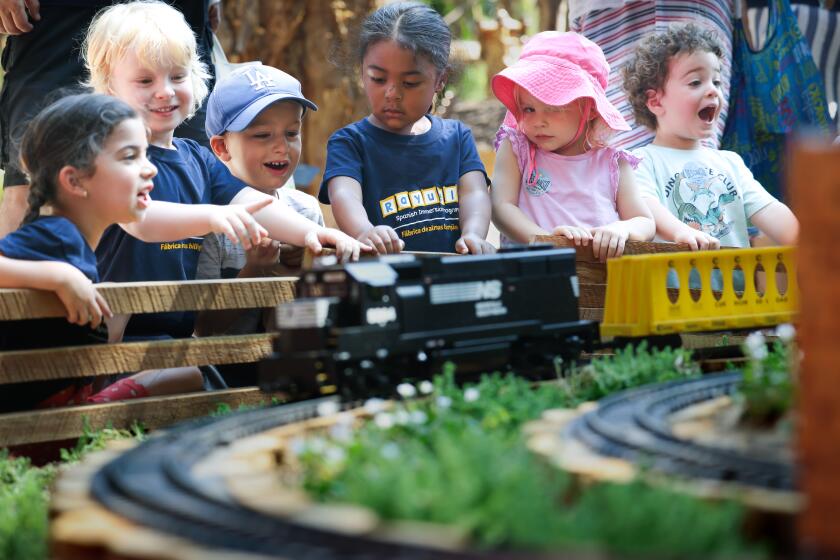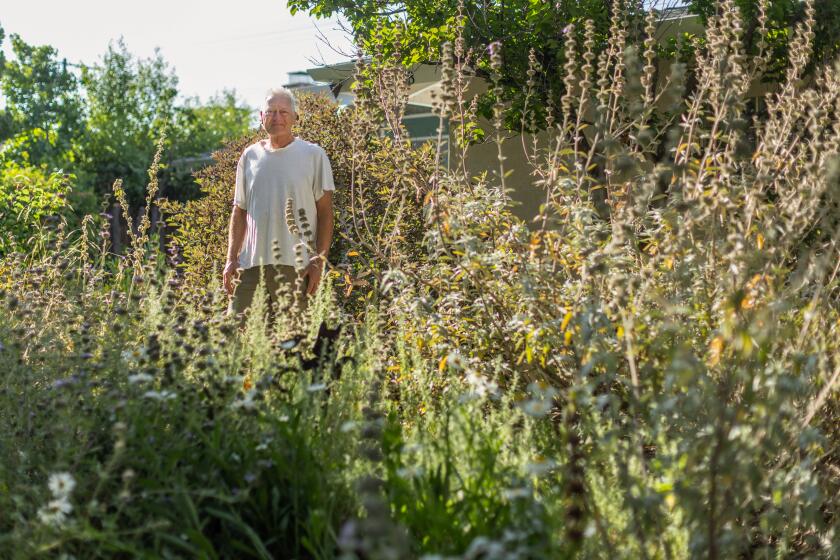Minor Manors : You Don’t Need to Be a Carpenter to Build a Kid’s Home Away From Home
When I was a kid, I had a playhouse that was the envy of the neighborhood. It was built by my mother, and it served as everything for the kids on my street. It was our spaceship. Our reading place. Headquarters for various clubs that we’d create.
Playhouses are places for children to pretend, to socialize and to retreat from the rules usually attached with playing “in the house.” And for parents, they offer an ideal way to keep kids safe at home without having them underfoot.
“It’s a great way to occupy their time,” said Mark Womble, who built a small playhouse for his children in a corner of his Costa Mesa back yard.
“It’s mostly self-defense,” he added, with a laugh.
One need not be an expert carpenter to put up a playhouse. Some planning, a little skill and an investment in wood and nails are enough.
Womble said he acquired his construction skills mostly by watching builders work on his home.
The little pale yellow cottage with the gray shingles is nestled in a corner of the yard under the shade of an avocado tree. It’s of a basic frame construction, and Womble was able to build it over three weekends using about $300 in lumber. Womble saved on lumber and made the structure more stable by using the back-yard fence as two of the walls, then covering all the walls with plywood.
The roof frame is made of 2-by-4s, and the plywood tilts downward from a center point toward each of the walls. Tiles cover the roof, protecting it from rain and also making it match the style of the Wombles’ real house.
Openings in the walls serve as the door and windows. But the absence of a real door and window glass hasn’t made the house any less enjoyable for his 4-year-old daughter, Jessie.
Womble worked from the ground up. He started by sinking cinder blocks into the ground (to keep cats from tunneling under the house), then rested the frame on the blocks.
A good foundation is as vital to a playhouse as to a real home, says Greg Olson, a recreation leader at Adventure Playground in Irvine, where children can build their own houses out of donated lumber.
“Check out the ground,” Olson advises. Hard soil is better than sand. Builders should also make certain that water won’t drain toward the playhouse site, since that will undermine the foundation.
Olson recommends using 2-by-8s for the floor frame, and that the frame be anchored. Concrete footings are an easy way to accomplish this. Once the footings are buried, the builder need only drive nails through the steel brackets on the footings and into the support posts for the playhouse.
Olson said builders should use exterior-use plywood, which is made with a waterproof glue. Surfaces that will be exposed to weather should be treated, he said.
Steve Ewald of Costa Mesa calls the strikingly designed playhouse he built for his daughter, Kelsey, “a ladder with a platform.” The small house sits above the ground, supported by a half-ladder and two 2-by-6 beams attached with lag screws to a nearby tree.
“The tree didn’t seem to mind at all,” Ewald said.
The braces also support swings.
The ladder leads through a trapdoor and onto a platform; the ladder posts were sunk into the ground with concrete. Eventually, Ewald hopes to build a catwalk along the beams that will lead to a new platform to be built in the tree. In the meantime, though, there is a slide at the front of the house that the adventurous can use for quick escapes.
Ewald, a stock investor, put his college art studies into use in designing the playhouse. Half-moon cutouts in the plywood of the house walls are complemented by the use of the moon-shaped pieces of wood as part of the ladder. A blue tarpaulin strapped down over the playhouse gives it a tentlike roof.
Ewald used carriage bolts in his construction, which allows him to tighten the screws periodically as they loosen. The wood, although not painted or stained, has weathered well.
Ewald said it took about two weeks to build the house, and that he spent about $350 for construction-grade redwood and plywood.
After he saw ready-made wooden play equipment selling for thousands of dollars, he figured he could do better, he said.
“I think that was one of the big motivations,” Ewald said. “It looked like something for me to make and save $2,000 bucks.”
The cost of lumber can surprise a lot of novice playhouse architects, said Kelly Hitchcock of ABC Lumber in Costa Mesa. Often, he said, people hope to replicate their homes in a playhouse that would have features such as wooden shingles and framed glass windows.
“Usually, the funds don’t match the ideas,” Hitchcock said.
As for what can be done without taking out a life-size mortgage, Hitchcock says his best advice is to plan. Sketch out what you want to build, draw up a lumber list and stick to it, he says.
“If everything is cut precisely, a monkey could put it together,” he said.
Letting the children get involved in the building can add to their fun. Pam Schader has a small fort in her Costa Mesa back yard that was built by a friend. Her son, Erich, was the “building assistant,” professional down to his equipment belt.
“He wore that hammer on his jeans for about a year and a half after it was completed,” she said.
Certainly at the Adventure Playground in Irvine, the ideal house seems to be not the one that looks the best but the one the children build themselves. There are about 30 houses scattered through the park, each constructed by a group of children.
“Usually teachers say, ‘Plan first,’ but it’s a lot more fun just to do it,” said Andrea Brown, 11, as she and a friend hammered away at their playhouse. Two walls were completed, and the other two were framed.
It didn’t look as if a roof would go up any time before the end of summer, but both seemed happy just to pound away.
Guides Make Building Child’s Play
Sunset and Ortho books offer simple plans for building playhouses for those with no carpentry experience.
Ortho’s “How to Design & Build Children’s Play Equipment” by Jay Beckwith ($6.95) has clear diagrams and instructions, but it concentrates more on climbing equipment. Sunset-Lane’s “Children’s Play Yards: Ideas, Plans, Projects” ($5.95) has detailed plans for a cottage.
Playhouse and play equipment kits are available from some lumber and building stores. Most are priced between $80 and $600, and they contain bolts, brackets and plans, and lists of lumber to be purchased.
More to Read
Sign up for Essential California
The most important California stories and recommendations in your inbox every morning.
You may occasionally receive promotional content from the Los Angeles Times.




